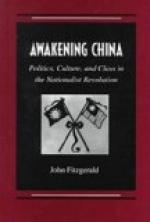Honan is a province rich in agricultural, and probably [Page 43] in mineral, resources, but it has no outlet in the way of trade. What a boon this railway is destined to be, as a channel of communication with neighbouring provinces!
I crossed the Yellow River in 1866, but there was then no bridge of any kind. Two-thirds of a mile in width, with a furious current, the management of the ferry-boat was no easy task. On that occasion an object which presented stronger attractions than this wonderful bridge had drawn me to K’ai-fung-fu—a colony of Jews, a fragment of the Lost Tribes of Israel. As mentioned in a previous chapter, I had come by land over the very track now followed by the railroad, but under conditions in strong contrast with the luxuries of a railway carriage—“Alone, unfriended, solitary, slow,” I had made my way painfully, shifting from horse to cart, and sometimes compelled by the narrowness of a path to descend to a wheelbarrow. How I longed for the advent of the iron horse. Now I have with me a jovial company; and we may enjoy the mental stimulus of an uninterrupted session of the Oriental Society, while making more distance in an hour than I then made in a day.
Of the condition of the Jews of K’ai-fung-fu, as I found them, I have given a detailed account elsewhere.[*] Suffice it to say here that the so-called colony consisted of about four hundred persons, belonging to seven families or clans. Undermined by a flood of the Yellow River, their synagogue had become ruinous, and, being unable to repair it, they had disposed of its timbers to relieve the pressure of their dire poverty. [Page 44] Nothing remained but the vacant space, marked by a single stone recording the varying fortunes of these forlorn Israelites. It avers that their remoter ancestors arrived in China by way of India in the Han dynasty, before the Christian era, and that the founders of this particular colony found their way to K’ai-fung-fu in the T’ang dynasty about 800 A. D. It also gives an outline of their Holy Faith, showing that, in all their wanderings, they had not forsaken the God of their fathers. They still possessed some rolls of the Law, written in Hebrew, on sheepskins, but they no longer had a rabbi to expound them. They had forgotten the sacred tongue, and some of them had wandered into the fold of Mohammed, whose creed resembled their own. Some too had embraced the religion of Buddha.
[Footnote *: See “Cycle of Cathay.” Revell & Co., New York.]
My report was listened to with much interest by the rich Jews of Shanghai, but not one of them put his hand in his pocket to rebuild the ruined synagogue; and without that for a rallying-place the colony must ere long fade away, and be absorbed in the surrounding heathenism, or be led to embrace Christianity.
I now learn that the Jews of Shanghai have manifested enough interest to bring a few of their youth to that port for instruction in the Hebrew language. Also that some of these K’ai-fung-fu Jews are frequent attendants in Christian chapels, which have now been opened in that city. To my view, the resuscitation of that ancient colony would be as much of a miracle as the return from captivity in the days of Cyrus.




